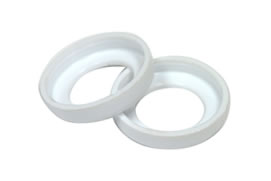
When shopping for washers, you may come across cupped washers. They are commonly used to distribute the load of threaded fasteners. Rather than only using a nut and bolt to secure two parts, for instance, you can use a cupped washer as well. While most washers offer load distribution, however, cupped washers feature a unique design that sets them apart.
What Are Cupped Washers?
Cupped washers are concave, ring-shaped fastening components. They are also known as Belleville washers — a reference to their inventor, Julien Belleville, who pioneered them in the 1860s.
Cupped washers are distinguished from other washers by their cupped or concave shape. While most other washers are flat, cupped washers are concave. This concave design allows them to resist vibrations and loosening.
Some of the materials in which cupped washers are made include the following:
- Stainless steel
- High-carbon steel
- Brass
- Aluminum
- Nylon
How Cupped Washers Work
Like all washers, cupped washers are used in conjunction with a threaded fastener, such as a bolt. You can insert a bolt through a cupped washer and two or more parts that you want to join. After twisting a nut onto the end of the bolt, the parts will remain secure.
The cupped washer will distribute the bolt’s load across a wider surface area so that the parts are better protected against damage. At the same time, the cupped washer will act like a spring to resist vibrations and loosening.
Because they are concave, cupped washer will deform under a load. As you drive a bolt through the center of a cupped washer, the head of the bolt will press against the sides of the washer. The cupped washer’s sides will then flatten. The now-flat cupped washer will apply an equal force against the bolt, thereby securing the bolt so that it’s better protected against vibrations and loosening.
When to Use Cupped Washers
You may want to use cupped washers in fastening applications where vibrations are a concern. Industrial machines and equipment, for instance, often feature cupped washers. When machines and equipment vibrate, the bolts used to hold them together may loosen or even fall out. A simple solution is to use cupped washers. Cupped washers will apply their own force once deformed, which helps to resist vibrations.
Cupped washers are commonly used in aerospace manufacturing as well. Airplanes and other types of aircraft typically vibrate during flight. Excessive vibrations can cause traditional washers to loosen. With their concave design, though, cupped washers are better protected against this phenomenon.



